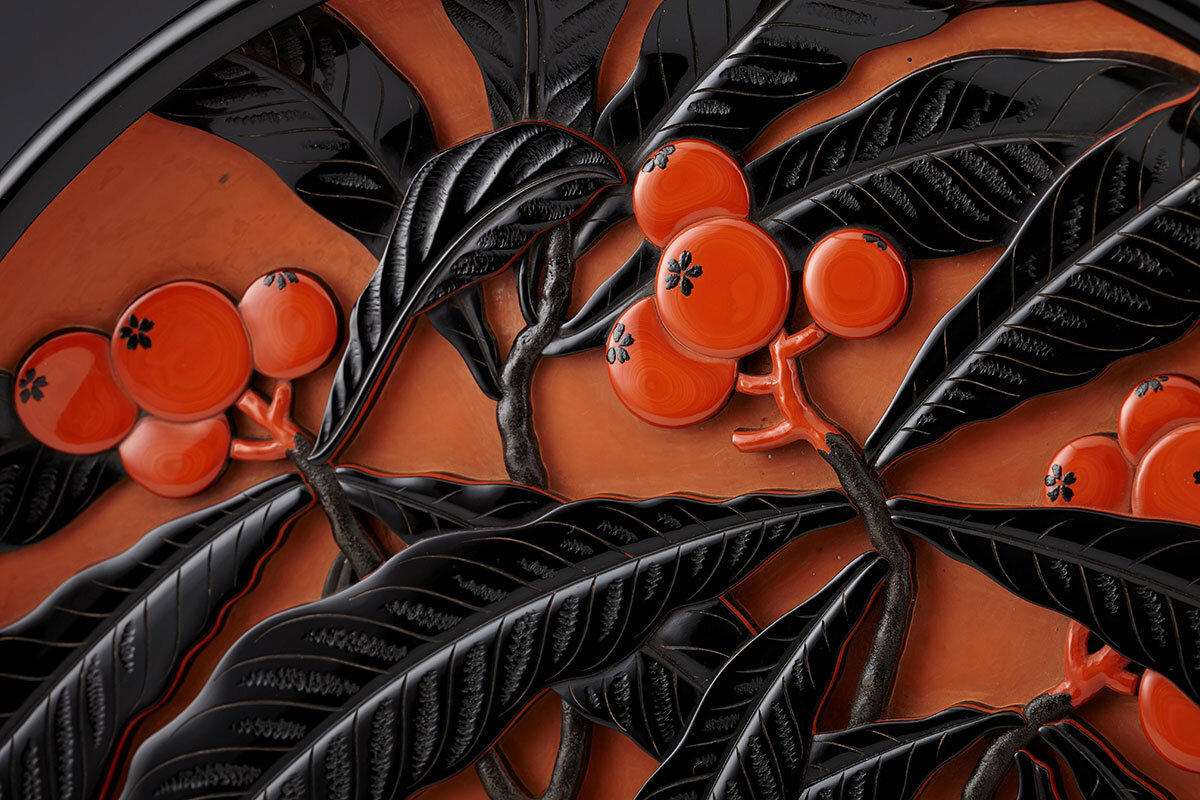MEIJI-TAISHO
CARVED LACQUER TRAY BY TSUISHU YOZEI XX
Kobon or incense tray in a circular form with a deep rim, ornamented with designs of fruiting Biwa branches on the face and stylized waves on the reverse. Of choshitsu or layered and carved orange and black lacquers, some finished in roiro or mirror-polished black, some portions in matte textured kawanuri lacquers, others in high-polished orange contrasting with a matte orange ground. Signed on the reverse with an incised signature by the artist: Yozei Tsukuru or Made by Yozei (Tsuishu Yozei XX, the go or art name of Tsuishu Toyogoro, 1880 – 1952). Taisho era, circa 1920.
With the tomobako or original box, inscribed on the exterior of the lid: Choshitsu Kobon or Sculpted Lacquer Incense Tray; and on the reverse of the lid titled: Biwa, and signed: Tsuishu Yozei Tsukuru or Made by Yozei, and sealed: Yozei.
Included in the box is a letter from the artist to the patron who commissioned the tray. Written as the piece was finished and delivered, it apologizes for raising the price on the lacquer to 1,000 Gold Yen, an amount sufficient to buy a very good house in the capitals of Tokyo or Kyoto. Apparently the piece entailed substantially more work than initially estimated. The power of the artist to price his work at this level and to raise the price to such a good client says a great deal about his reputation and the Japanese art market in the first decades of the 20th century.
Born to a Kyoto family that had specialized in the creation of carved lacquers since the 14th century, Tsuishu Yozei XX is famous for revitalizing and modernizing the art form. He studied maki-e or raised gold lacquering under Shirayama Shosai, sculpture under Ishikawa Komei, and painting under Satake Eiko. He succeeded to the family title in 1896. In 1900, he won a bronze plaque at the Paris World Exposition. At the 1907 Tokyo Industrial Exposition he won a second prize and in 1909 became a counselor to the Japan Crafts Association. In 1913, he exhibited at the first Noten exhibition, displaying and winning prizes at every subsequent exhibition until 1922. In 1923, he founded the Yozei-kai art association and in 1924 held a one-man show at Takashimaya in Osaka (the Japanese equivalent of a prestigious Western art gallery). In 1925, he won a grand prix at the Paris Exposition des Arts Decoratifs (the great Art Deco exposition). From 1927, he exhibited annually at the Imperial Art Exhibition, beginning with the 8th Teiten. In 1928, he was awarded the Order of the Green Cordon. In 1929, the Yozei-kai published the Tsuishu Sakuhin Zuroku (Catalogue of Works by Tsuishu). In 1934, he held an exhibition of his carved lacquer works at Mitsukoshi in Tokyo and in 1936 participated in the foundation of the Japan Academy of Lacquer Art. From 1937, he exhibited at the Shin-Bunten (the successor to the Teiten). After the Pacific War, he returned to the government sponsored art exhibitions with the 2nd Nitten in 1946 and the 5th Nitten in 1949, thereafter showing annually in that venue. Tsuishu Yozei XX became a counselor of the Nitten in 1950, and died in November of 1952.
For a similar but slightly less complex version of this tray, c.f. the Tsuishu Sakuhin Zuroku, the third to last color plate, right side.
Not every object an artist creates seems equal. Some reach an amazing balance of color, texture, elegance of composition and technical excellence. Yozei’s carving of the biwa, the play of texture between matte and polished, the use of kawanuri crushed lacquer to render the branches, and the deep level of carving can only be described as extraordinary. Then one turns the tray over and sees the flowing waves curling around the sides, and smiles.
Carved Lacquer Tray by Tsuishu Yozei XX
Artist Name: Tsuishu Yozei XX
Period: Meiji Taisho
Mediums: Lacquer
Origin Country: Japan
1 5/8” high x 11” diameter
This piece is no longer available.







